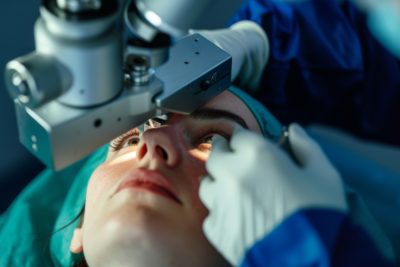Key Takeaways
- Refractive errors like myopia, hyperopia, astigmatism, and presbyopia are correctable through eye glasses or contact lenses, until the limitations of that modality are reached.
- Contact lenses factor in freedom and confidence, but must be used correctly to avoid dryness and possible infection.
- Refractive surgeries: PRK, LASIK, and SMILE remove corneal tissue in the shape and pattern of the various refractive errors, reducing the need for glasses or contacts.
- LASIK and CONTOURA LASIK have rapid recovery times, with reduced glare and halos using CONTOURA LASIK.
- SMILE is a bladeless, flapless procedure with fast recovery good for those who had a higher refractive error.
Refractive errors are the most common treatable cause of vision impairment throughout the world .The commonly encountered refractive errors are myopia (near sightedness), Hyperopia (far sightedness), Astigmatism and Presbyopia. These can be easily corrected with glasses / contact lenses. Nevertheless, these are not permanent means of correcting the refractive error and have their own drawbacks. In patients with very high power, spectacles can cause minification / magnification of images and cause significant visual discomfort.
Thanks to the existence of contact lenses, it is sometimes impossible to tell if someone has a visual impairment or not. These lenses can make a huge difference to the lives of people, providing a certain level of freedom and confidence that traditional glasses are unable to. Yet they do come with certain limitations that it has to be worn for a limited number of hours in a day, it can cause severe dryness of the eye in some people and sterile precautions needs to be taken all the time while application and removal to prevent any infections.
Thus refractive surgeries are the most trending means of correcting the refractive error, thereby eliminating / reducing the need for glasses / contact lenses .They change the focusing ability of the cornea by reshaping the surface using lasers.
A detailed evaluation of the patient’s eye is done including corneal scans to determine suitability and safety of the surgery and to decide on the type of surgery. The commonly performed laser procedures are Photo Refractive Keratectomy (PRK), Microkeratome LASIK, Femtosecond LASIK, Contoura and Small Incision Lenticule extraction (SMILE). Thanks to the latest technologies and recent advances that these are virtually painless procedures with total surgical time requiring not more than 5 minutes per eye. Topical anaesthetic drops are applied prior to the procedure to numb the cornea and the patient hardly experiences any pain during the entire procedure.
PRK procedure involves removal of a thin superficial layer of cornea (epithelium), followed by application of laser. The epithelium grows back over the corneal surface in about 3-5 days. This being the most basic type of surgery is suitable for correcting low – moderate refractive error only and visual recovery takes a slightly longer time compared to the other procedures Nevertheless, this procedure is safer especially in patients with thinner corneas where LASIK is contraindicated.
LASIK is a flap based procedure where in the flap is created using a specialised blade (called Micro keratome) or by using Femtosecond laser. LASIK is an excellent procedure for correction of powers upto about 8 to 10 Diopters provided the corneal thickness is sufficient and there are no irregularities in the shape of the cornea. Nonetheless, it can cause dryness in certain patients which partially or completely recovers 3-6 months post – operatively.
CONTOURA LASIK is a recent advancement in the laser vision correction. It removes corneal micro irregularities to create an optically perfect smooth surface. It offers advantages over the normal LASIK by almost completely eliminating glare and halos in dim light and enhances the visual quality and contrast sensitivity.
The most advanced technology available now is the ReLEx SMILE which is performed using the Femtosecond laser platform VISUMAX (Carl Zeiss Meditec, Germany®). It is a bladeless, flapless procedure where in a very small incision of 2mm is made by the laser and a thin layer of corneal tissue is removed which in turn flattens the cornea and there by corrects the refractive error. It has advantages over the other procedures that it can safely correct higher refractive errors and can also be done in borderline thin corneas where other procedures are contraindicated. The incidence of dryness is minimal and is not associated with any flap related complications. The visual recovery is much faster and the patient can resume all normal activities as early as 2-3 days .Nonetheless, this procedure cannot be performed for very high refractive error (>10 Diopters).
For patients with very high refractive errors where none of the above laser based procedures can be done, there is an option called ICL/ Implantable Collamer Lens. These are safe, high quality contact lenses which are injected into the eye through a micro incision and are placed in front of the normal crystalline lens.
Talk to your ophthalmologist regarding your visual needs and expectations who in turn can help you decide on the safest and the best option to correct your refractive error!









